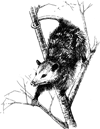Vertebrate Pest Conference Proceedings collection
Date of this Version
February 1994
Abstract
Difenacoum and bromadiolone treatments against Norway rats may fail because: 1) the animals eat little or no bait, 2) reinvasion rapidly offsets any success, or 3) the population contains resistant individuals. By monitoring bait takes and employing independent measures of rat activity such as tracking plates, it is possible to identify, often in the early stages of a treatment, patterns that indicate the contribution of each of these causes to the eventual outcome. If there is no bait take from the majority of bait points visited by rats in the first week then the treatment is unlikely to be successful, no matter how long it continues. Furthermore, treatments carried out on arable farms, where cereals are stored and the environment is relatively undisturbed, are likely to be less successful than those carried out on livestock farms, where alternative food may also be abundant but where the environment is less predictable. Bait takes that persist at the same bait points for longer than 16 days strongly suggest the presence of resistant rats, while immigration may be significantly affecting the treatment if takes recur at more than 30% of points after a period of seven days. Once a given problem has been identified remedial measures can be taken.

